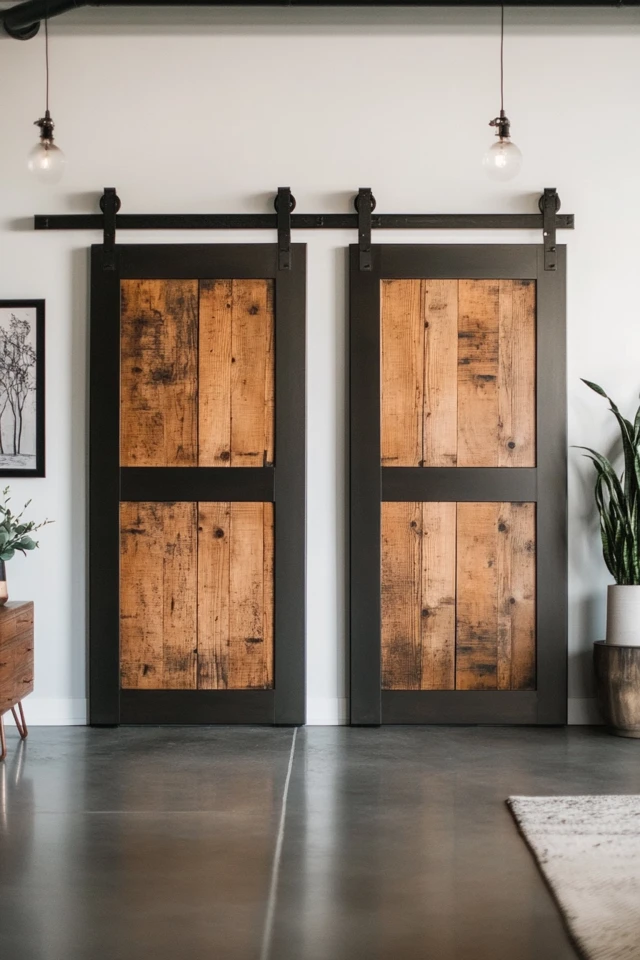Industrial sliding doors are not just functional—they’re a statement piece. Whether they’re used to divide rooms, conceal storage, or as a dramatic entryway, these doors capture the raw, utilitarian essence of industrial design. Crafted from materials like metal, glass, and reclaimed wood, industrial sliding doors bring a bold yet practical edge to open spaces.
I vividly remember incorporating a pair of steel-and-glass sliding doors in a loft renovation project. The way the doors effortlessly glided open while maintaining the airy, industrial vibe was pure magic. They allowed light to flow freely between spaces while still providing separation when needed. Since then, industrial sliding doors have become one of my favorite ways to add both style and functionality to open spaces.
In this guide, we’ll explore the best industrial sliding doors for open spaces, their unique features, and tips for incorporating them into your design.
Why Choose Industrial Sliding Doors?
1. Saves Space
Sliding doors don’t require the swing radius of traditional doors, making them ideal for tight spaces or layouts that need flexibility.
2. Enhances Light Flow
Doors with glass panels allow natural light to flow freely between rooms, creating a bright and airy feel.
3. Adds Character
Industrial sliding doors often feature raw materials and bold hardware, adding personality and charm to your space.
4. Increases Functionality
Use them to divide open spaces, conceal clutter, or create privacy while maintaining a seamless design aesthetic.
Key Features of Industrial Sliding Doors
1. Raw Materials
- Metal: Black steel, iron, or aluminum frames for a bold industrial look.
- Glass: Clear, frosted, or textured panels to maintain light flow while adding privacy.
- Reclaimed Wood: Distressed or weathered wood panels for a rustic-industrial feel.
2. Bold Hardware
- Exposed sliding tracks and rollers are iconic features of industrial sliding doors.
- Black or brushed metal finishes keep the look sleek and edgy.
3. Customizable Sizes
- Sliding doors can be tailored to fit large openings, making them perfect for open-concept layouts.
Types of Industrial Sliding Doors
1. Steel and Glass Sliding Doors
- Why It Works: The combination of steel frames and glass panels is the quintessential industrial look, balancing strength with transparency.
- Best Use: Divide living spaces, create home offices, or section off kitchens without blocking light.
- Design Options:
- Single-panel sliding doors for a minimalist aesthetic.
- Multi-panel grid designs for a bold, factory-inspired vibe.
Pro Tip: Use frosted or ribbed glass for added privacy while maintaining an industrial edge.
2. Reclaimed Wood Sliding Barn Doors
- Why It Works: Reclaimed wood adds warmth and texture, making it an ideal choice for softening industrial interiors.
- Best Use: Conceal closets, laundry rooms, or pantries, or use as a dramatic focal point.
- Design Options:
- Chevron or herringbone patterns for a modern twist.
- Distressed finishes for a rustic-industrial look.
Pro Tip: Pair reclaimed wood doors with black metal hardware for a cohesive design.
3. Metal Sliding Doors
- Why It Works: Full-metal sliding doors create a sleek, industrial feel and are incredibly durable.
- Best Use: Perfect for high-traffic areas or commercial spaces with a modern-industrial aesthetic.
- Design Options:
- Solid metal panels for bold statements.
- Perforated or laser-cut designs for added visual interest.
Pro Tip: Choose a matte black or brushed steel finish to keep the look clean and contemporary.
4. Glass Pocket Sliding Doors
- Why It Works: Pocket doors slide into the wall, completely disappearing when open, making them a sleek and space-saving option.
- Best Use: Divide smaller spaces or add a modern touch to bathrooms and bedrooms.
- Design Options:
- Clear glass for openness.
- Tinted or frosted glass for privacy.
Pro Tip: Use black-framed glass panels to maintain an industrial look while maximizing space.
5. Mixed Material Sliding Doors
- Why It Works: Combining materials like metal, wood, and glass creates a dynamic, multi-textured look that stands out.
- Best Use: Use in larger spaces where the door can act as a statement piece.
- Design Options:
- Reclaimed wood panels with glass inserts.
- Metal frames with textured glass for added depth.
Pro Tip: Match the door’s materials with other elements in the room, like exposed beams or metal accents.
Picture Gallery

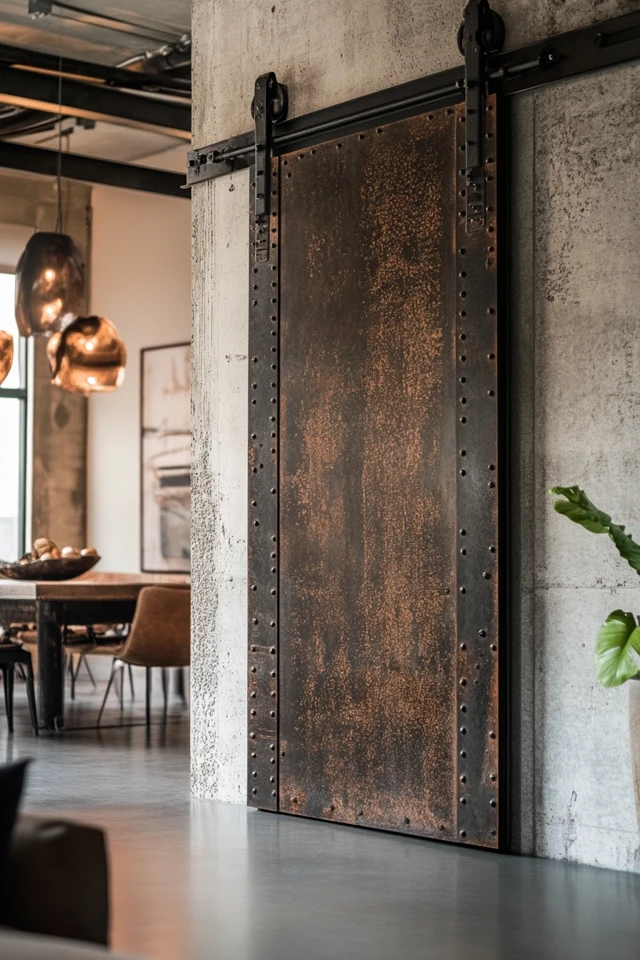
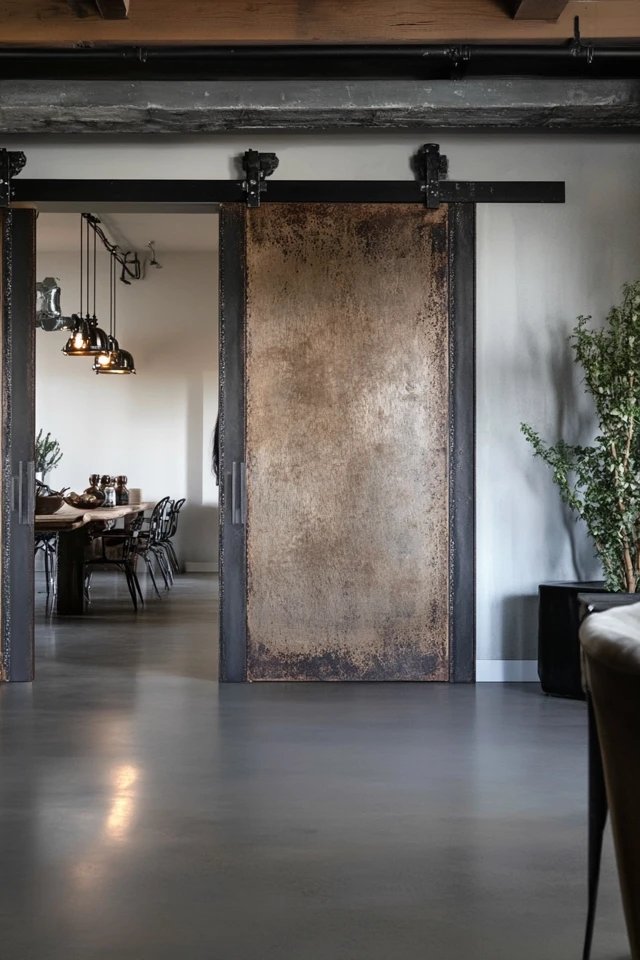
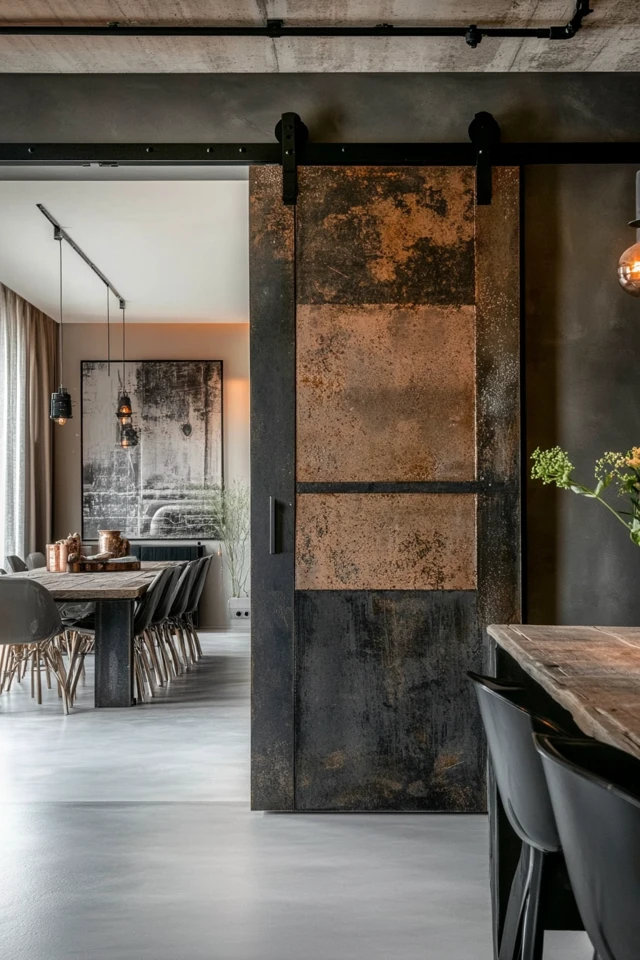
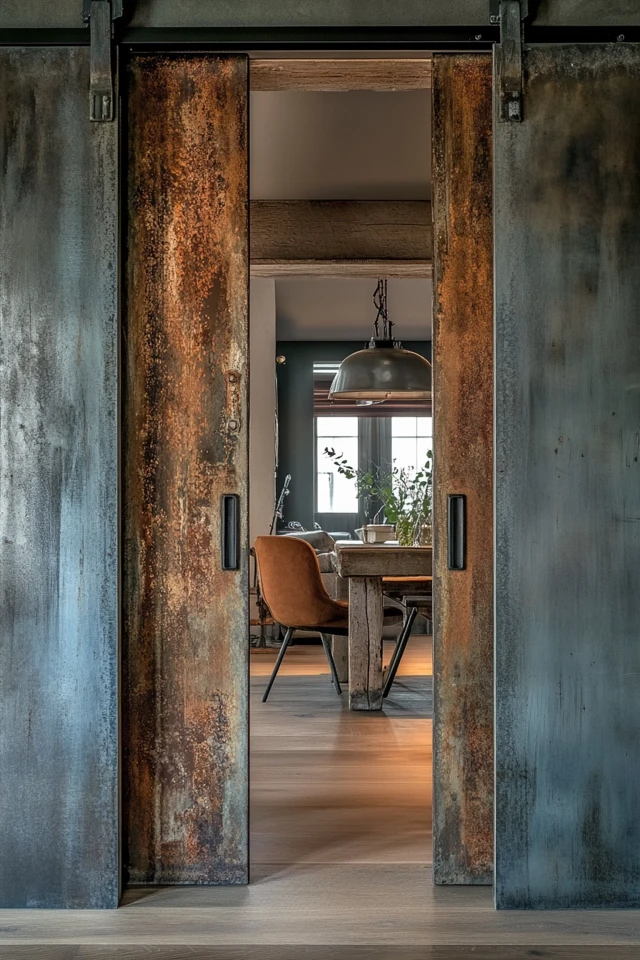
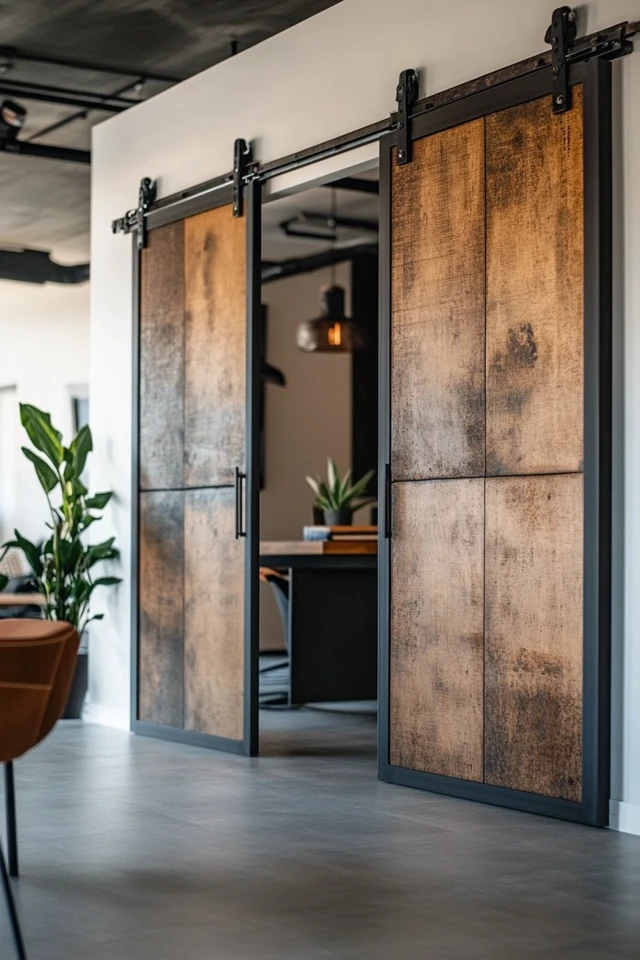
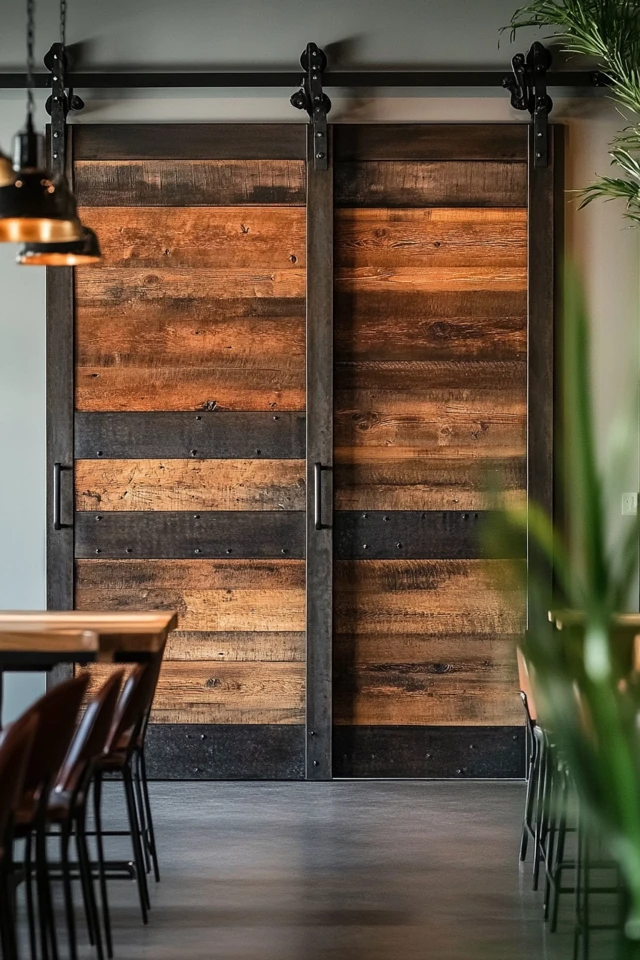
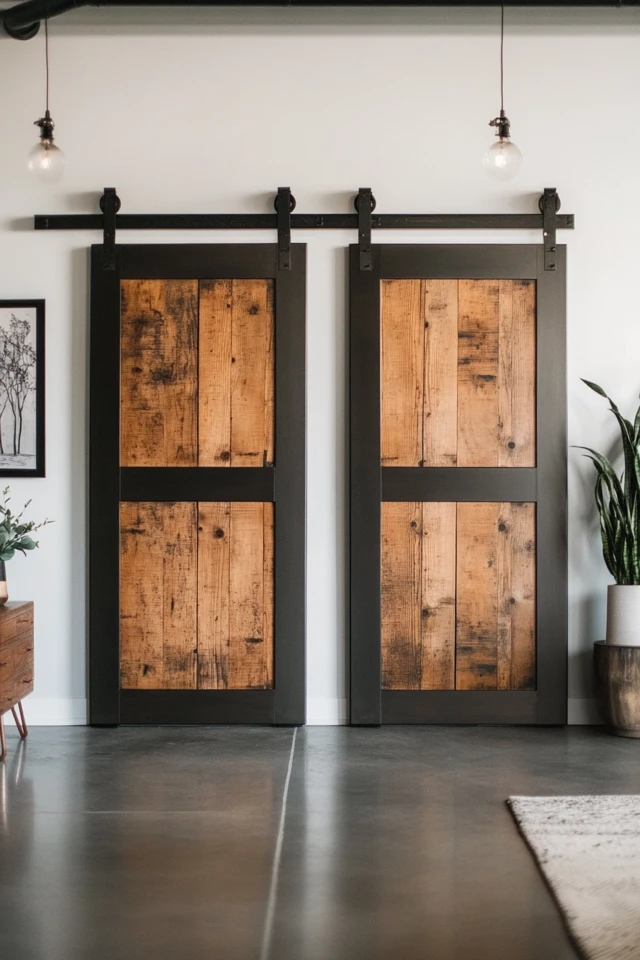
How to Incorporate Industrial Sliding Doors in Your Space
1. Define Zones in Open-Concept Layouts
Use sliding doors to create flexible zones in open-concept spaces. For example:
- Divide the living and dining areas with glass-and-metal doors to maintain light flow.
- Create a private home office without losing the open feel.
Pro Tip: Choose clear or frosted glass to maintain visual connectivity between spaces.
2. Add Character to Entryways
Replace traditional doors with bold sliding doors to make a statement in entryways or hallways.
- Use reclaimed wood barn doors for a warm, inviting feel.
- Opt for steel and glass doors to create a sleek, modern-industrial look.
Pro Tip: Use oversized sliding doors to fill wide openings and enhance the visual impact.
3. Conceal Functional Spaces
Industrial sliding doors are perfect for hiding less glamorous areas, like laundry rooms, pantries, or storage spaces.
- Use reclaimed wood doors for a rustic touch.
- Choose metal or full-panel doors for a more utilitarian look.
Pro Tip: Match the door’s hardware with other metal finishes in the room for a cohesive design.
4. Create Flexible Privacy Solutions
Sliding doors offer privacy without making spaces feel closed off.
- Use frosted or textured glass doors in bedrooms or bathrooms.
- Install double sliding doors for larger openings to create a dramatic, flexible partition.
Pro Tip: Add soft-close hardware for a smoother and quieter sliding experience.
Styling Tips for Industrial Sliding Doors
1. Highlight the Door’s Hardware
Exposed tracks and rollers are a signature feature of industrial sliding doors. Choose bold finishes like black, brushed steel, or brass to make them stand out.
2. Layer with Curtains
For added privacy or softness, layer sliding doors with neutral curtains or sheer panels.
3. Keep Surrounding Décor Minimal
Let the sliding door be the star by keeping surrounding walls and furniture simple and understated.
4. Add Lighting
Install track lighting or sconces above the sliding door to highlight its design and enhance its presence in the space.
Conclusion
Industrial sliding doors are the perfect blend of function and style, bringing character, flexibility, and a bold statement to open spaces. Whether you choose steel and glass, reclaimed wood, or a mix of materials, these doors add an edgy yet timeless appeal to any interior.
By incorporating the right materials, hardware, and design elements, you can create a sliding door that not only enhances your space but also reflects your personal style. Ready to make a bold move? Let an industrial sliding door redefine your open space today!
FAQs
1. Can I install industrial sliding doors in small spaces?
Yes! Sliding doors are perfect for small spaces since they don’t require the swing radius of traditional doors. Consider pocket doors or compact single-panel designs.
2. Are industrial sliding doors easy to maintain?
Most industrial sliding doors are low-maintenance. Wipe down metal and glass surfaces regularly, and ensure tracks and rollers are free of debris for smooth operation.
3. How much do industrial sliding doors cost?
Prices vary depending on materials and size, but they typically range from $500 to $2,500. Reclaimed materials or DIY options can help lower costs.
4. Can I use industrial sliding doors outdoors?
Yes! Sliding doors made of weather-resistant materials like steel and treated wood are great for patios or garden spaces.
5. Where can I find industrial sliding doors?
Check out retailers like Wayfair, Home Depot, and specialty stores like Rustica or Etsy for a wide range of options. Custom doors can also be made by local craftsmen or metalworkers.

